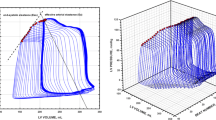Summary
In early systole, before the effects of reflected waves from the periphery become significant, the following equation applies:
where PA and PO are the instantaneous and end-diastolic pressures in the ascending aorta,ρ the density of blood, c the velocity of the pulse wave in the aorta, and u the velocity of blood. Differentiation of Eq. (1) with respect to time t yields:
If there is no aortic stenosis, and if the pressure gradient due to the inertia of the blood during acceleration is neglected, the left ventricular pressure P is nearly equal to PA during the ejection period. Since both dP/dt and dPA/dt take their maximum values at times close to the time of aortic valve opening, the following equation applies:
where Max signifies the maximum value of a derivative. Equation (2) reduces to:
Substitution of Eq. (4) into Eq. (3) yields:
Experiments were performed on seven dogs. Max(dP/dt), Max(du/dt), and c were measured during volume loading, pressure loading and unloading, and before and after administration of positive and negative inotropic agents.
There was a good linear correlation (Y=1.01X−2, r=0.97) between Max(dP/dt) andρcMax(du/dt). Therefore, Eq. (5) is a universal equation which holds, irrespective of the dogs and interventions employed to change the hemodynamic state. The absolute value of Max(dP/dt) of the left ventricle can be obtained by measuring noninvasively the velocity of the pulse wave and the maximum acceleration of blood in the ascending aorta.
Similar content being viewed by others
References
Braunwald E, Ross J Jr, Sonnenblick EH (1976) Mechanisms of contraction of the normal and failing heart, 2nd edn. Little, Brown and Company, Boston, pp 130–165
Benett ED, Else W, Millar GAH, Sutton GC, Miller HC, Noble MIM (1974) Maximum acceleration of blood from the left ventricle in patients with ischaemic heart disease. Clin Sci Molec Med 46: 49–59
Jewitt D, Gabe I, Mills C, Maurer B, Thomas M, Shillingford J (1974) Aortic velocity and acceleration measurements in the assessment of coronary heart disease. Eur J Cardiol 1: 299–305
Wallmeyer K, Wann S, Sagar KB, Kalbfleisch J, Klopfenstein HS (1986) The influence of preload and heart rate on Doppler echocardiographic indexes of left ventricular performance: comparison with invasive indexes in an experimental preparation. Circulation 74: 181–186
Sabbah HN, Khaja F, Brymer JF, McFarland TM, Albert DE, Synder JE, Goldstein S, Stein PD (1986) Noninvasive evaluation of left ventricular performance based on peak aortic blood acceleration measured with a continuous-wave Doppler velocity meter. Circulation 74: 323–329
Light H (1976) Transcutaneous aortovelography: a new window on the circulation? Br Heart J 38: 433–442
Sequeira RF, Light LH, Gross G, Raftery EB (1976) Transcutaneous aortovelography: a quantitative evaluation. Br Heart J 38: 443–450
Buchtal A, Hanson GC, Peisach AR (1976) Transcutaneous aortovelography: potentially useful technique in management of critically ill patients. Br Heart J 38: 451–456
Sugawara M, Nakata S (1985) Relation between the maximum acceleration of blood in the aorta and maximum dP/dt of the left ventricle. Proc 46th Meeting Jpn Soc Ultrason Med: 751–752 (abstract)
Jones RT (1972) Fluid dynamics of heart assist devices. In: Fung YC, Perrone N, Anliker M (eds) Biomechanics: its foundation and objectives. Prentice-Hall, Englewood Cliffs, pp 549–565
McDonald DA (1974) Blood flow in arteries. Edward Arnold, London, pp 284–285
Caro CG, Pedley TJ, Schroter RC, Seed WA (1978) The mechanics of the circulation. Oxford University Press. Oxford, pp 282–283
Taylor MG (1964) Wave travel in arteries and the design of the cardiovascular system. In: Attinger EO (ed) Pulsatile blood flow. McGraw-Hill, New York, pp 343–372
Landau LD, Lifshitz EM (1959) Fluid mechanics. Pergamon, Oxford, pp 366–367 (translated by Sykes JB Reid WH)
van den Bos GC, Westerhof N, Randall OS (1982) Pulse wave reflection: Can it explain the difference between systemic and pulmonary pressure and flow waves? Circ Res 51: 479–485
Noble MIM (1968) The contribution of blood momentum to left ventricular ejection in the dog. Circ Res 23: 663–670
McDonald DA (1968) Regional pulse-wave velocity in the arterial tree. J Appl Physiol 24: 73–78
Author information
Authors and Affiliations
Rights and permissions
About this article
Cite this article
Harada, Y., Sugawara, M., Beppu, T. et al. Principle of a noninvasive method of measuring Max(dP/dt) of the left ventricle: Theory and experiments. Heart Vessels 3, 25–32 (1987). https://doi.org/10.1007/BF02073644
Received:
Revised:
Accepted:
Issue Date:
DOI: https://doi.org/10.1007/BF02073644




